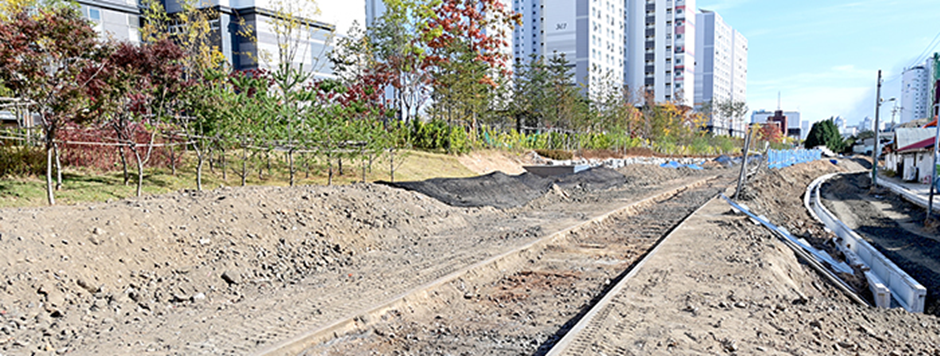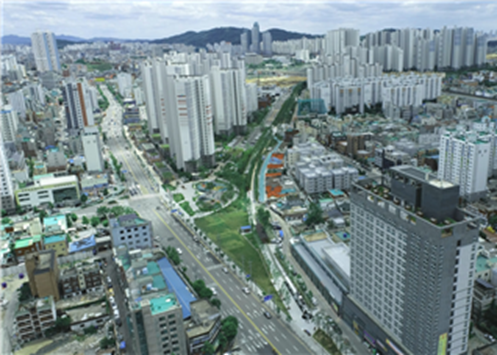New urban forest prevents heat build-up and heat waves in the city, and also blocks out traffic noise
The urban forest project launched by Incheon as a countermeasure against climate change appears to be delivering some promising results in terms of mitigating heat build-up and reducing dust particulates polluting the city.
Results from the Urban Forest Functionality Survey done by the Incheon Health and Environment Research Institute (Incheon HER) revealed that urban forests had higher amounts of phytoncide and anions than the urban control group, while keeping temperature and ambient noise levels lower than the control group.
The Incheon HER studied eight urban forests from May to October, including forests in Freedom Park, SubongPark, Cheongnyangsan Forest Recreation Park, Songdo Sunrise Park, Jungang Park,Hambong Park, Gyeyang Park, and Cheongna Lake Park for its Urban Forest Functionality Survey.

▲ Quoting results from its Urban Forest Functionality Survey, the Incheon Health and Environment Research Institute (Incheon HER) revealed that urban forests had higher amounts of phytoncide and anions than the urban control group, while keeping temperature and ambient noise levels lower than the control group. Image of the “Urban Wind Forest Groundbreaking Ceremony” at Sungui Station on the Suin Line in Michuhol-gu (2021).
Monthly measurements of eight different phytoncides, anions, ambient noise levels, temperature, and humidity, the average concentration of phytoncide in eight urban forests was 259pptv, which was 3.1 times higher than the control location at 84pptv. As for temperature and humidity, the temperature was 2.9℃ lower on average, whereas humidity was 12.3% higher than the control location, meaning the urban forests were indeed effective in improving the thermal environment in the city center. Anionic water and ambient noise levels were 2 times higher on average and 8.5dB lower, respectively, compared to the control location.
Overall, the results prove just how effective urban forests can be in terms of controlling heat waves, alleviating heat build-up, and reducing traffic and ambient noise in the city center.
Among the eight phytoncides,α-Pinene (30%), Camphene (24%), and β-Pinene (20%), which are effective in relieving stress and promoting recovery from fatigue, were the most commonly available phytoncides.
Moreover, forest parks located in the old city center were found to be rich in phytoncide and anions, and to have lower ambient noise levels as well as temperature levels than newly created forests.
This year, Incheon is focusing on building community forests... More green space in urban areas and roads lined with luscious trees
With the climate crisis now a ticking time bomb, Incheon has been discussing a variety of climate solutions. One particular solution that has been turning heads is the urban forest initiative, which is designed to combat the climate crisis by restoring and expanding green spaces in the city.
Urban forests feature forests and tree-lined streets created and managed for public health, recreation, and psychological benefits. They include parks, school forests, and roadside trees.
Incheon’s 5-year urban forest creation project, which began in earnest in 2019, is expected to bear fruit this year.

▲ Image from the Baramgil Forest along the Suin subway line.
Once the three urban “windtrail” forests, four forests within Salamander City Ecological Park, green space surrounding the 2nd Gyeongin Expressway, Cheongna green space, and other landscaping projects open this year, Incheon will secure 17.68ha in urban windtrail forests in 13 planned zones. In total, the City’s goal is to secure 42.05ha in urban forests across 25 locations.
The project to create a child-safe green forest, which started in 2021, is also expected to be completed this year with a total of ten venues totaling 0.92ha. Incheon will add four additional venues at Jungsan Elementary School and Haneul Elementary School in Jung-gu and Gawon Elementary School and Gongchon Elementary School in Seo-gu.
Starting this year, the Metropolitan City Government is also looking to focus more on bringing green spaces closer to the public.
The City will build more school forests by planting trees, creating wild gardens, and opening nature experience venues in seven elementary, middle, and high schools across Incheon. Small indoor greens (smart gardens) will also open in 32 locations scattered across industrial complexes without sufficient outdoor spaces.
Meanwhile, the City Hall is getting a “green” makeover as well. In the main building, the wall and flower beds will be used to create an urban forest, and in Love Square, flowers will be planted year-round to help everyone spend a part of their day immersing themselves in nature.
In particular, this year, Incheon is focusing its efforts on creating roads lined with luscious trees that fit the characteristics of each district.
The plan is to create a streetscape with distinct trees, which can then serveas tourist attractions themselves.
In doing so, the City Administration will assess the stability of trees on the roadside, and establish a comprehensive safety management system based on scientific data. Incheon wants to complete this risk assessment and diagnosis by June and take safety measures before the rainy season later in the year.
The City is investing KRW 1.35billion to build these specialized streets along locations like the Jemulryang-ro in Jung-gu, and KRW 570 million in the diagnosing trees lining roads such as Chukhang-daero in Jung-gu.